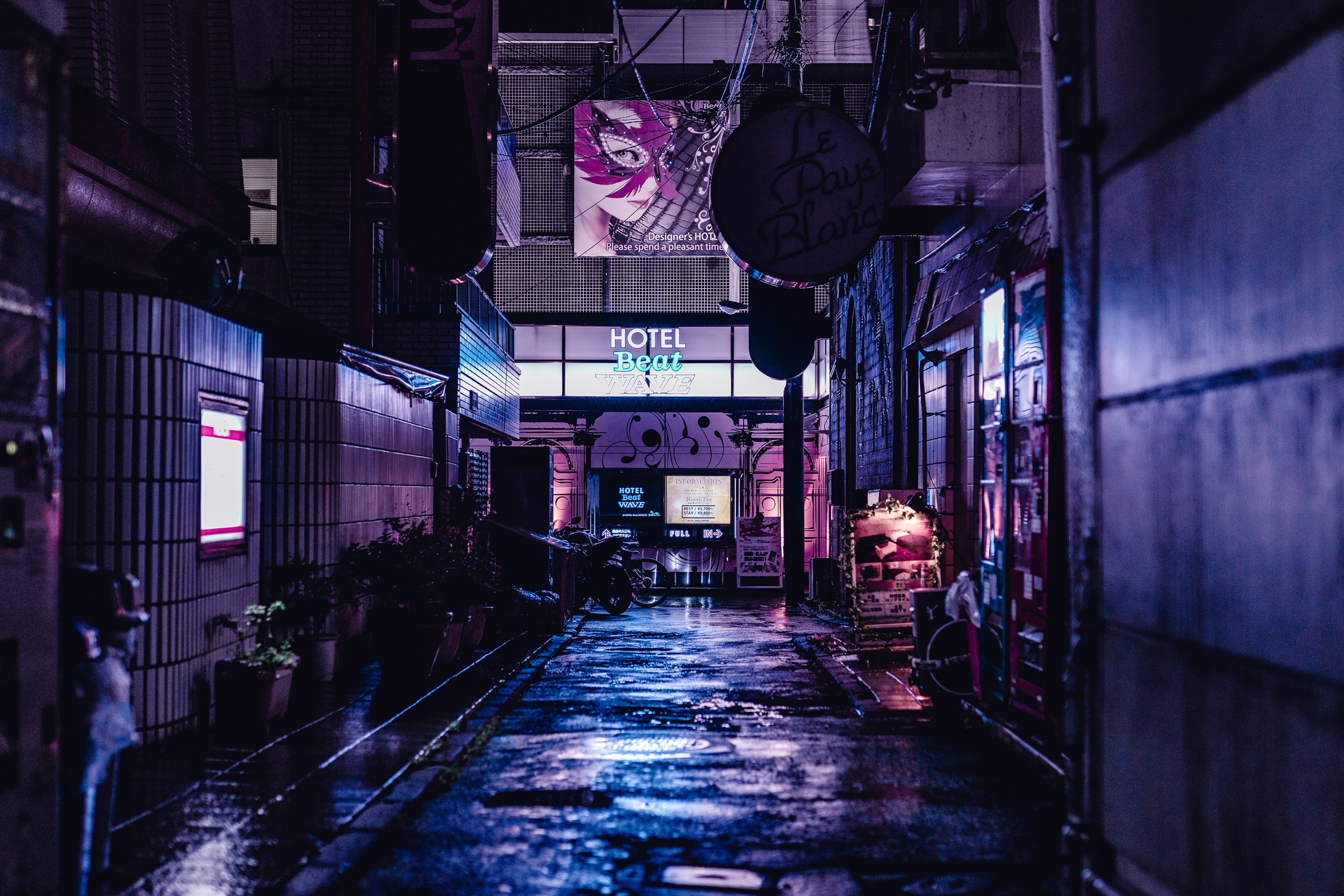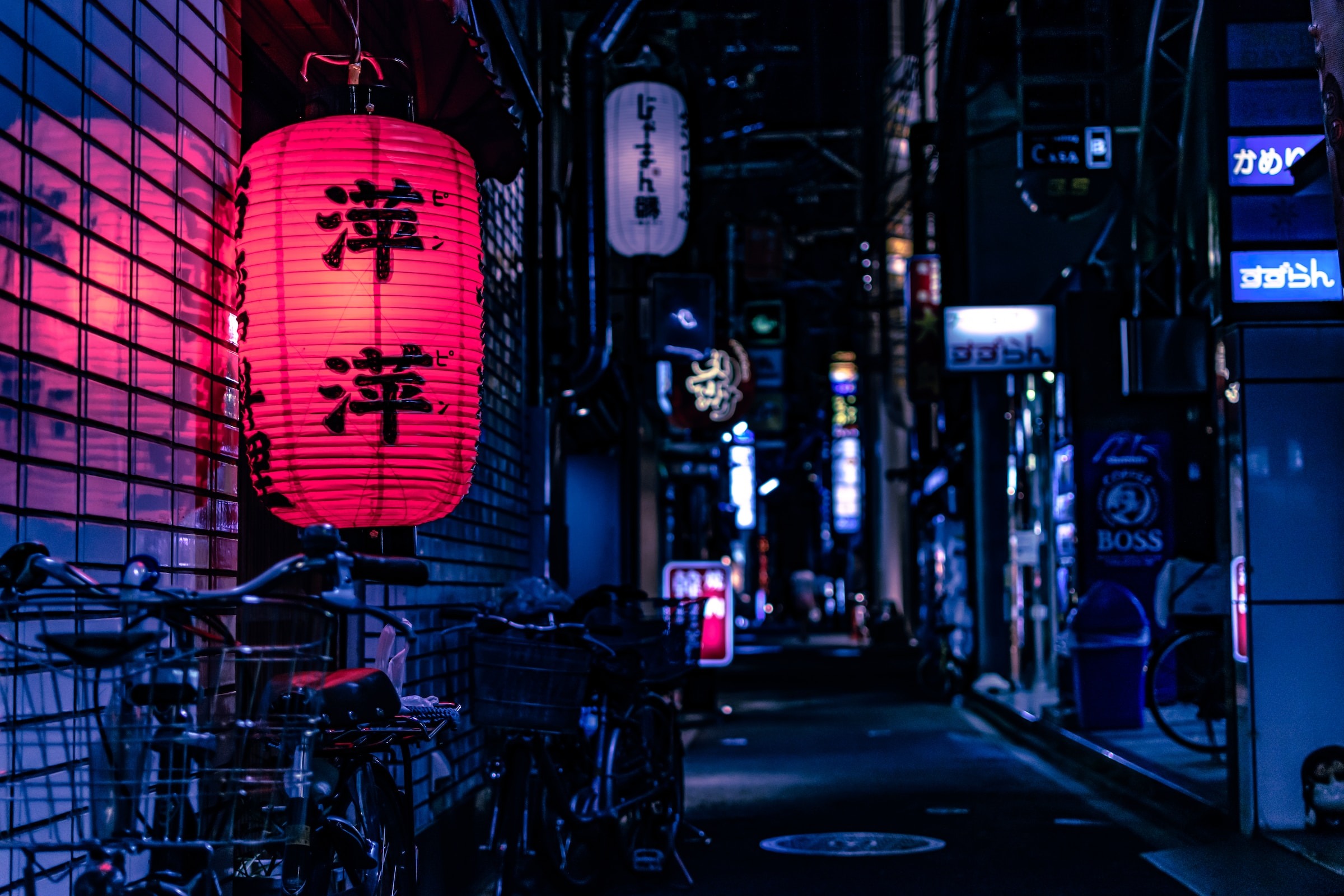Kuchisake-onna: The Slit-Mouthed Woman

By Richard Milner
Staff Writer
26/10/2019

In the black, back alleys of Kabukicho, Tokyo’s red-light district, a lone businessman stumbles home at 3 am. His suit is wrecked, his briefcase dangles loosely from his fist, his mind spinning in an alcoholic haze.
Ahead of him down a single, narrow lane glides a slender, feminine figure in a long, beige trench coat. Raven hair spills down her back, and a set of piercing, sable eyes peer out from above a snow-white surgical mask strapped across her nose and mouth.
He slows as she approaches and leans in.
“Am I pretty?” she lilts.
“Of course!” he responds instinctively, considering all the ways this encounter could go.
She says nothing, and instead lifts a hand to her mask, pulling off one side and letting it hang.
“How about now?” she grins.
The businessman’s briefcase falls from nerveless fingers and he shrieks and stammers no, no, no. She slides a long, gleaming set of scissors out of her coat and brandishes it above her head before plunging it into his gut and cutting all the way to his spine. The two halves of his body collapse to the ground and bleed out.
His dead eyes stare up at the lopsided, torn smile of his killer, stretching from ear to ear.
***
Death and maiming are predetermined when confronted with the vengeful spirit of Kuchisake-onna, or the Slit-Mouthed Woman, a yokai, a monstrous creature of Japanese folklore. Reply “no” to her first question, and she will rend you in half or sever your head. Reply “yes” to her second question, and she will use her scissors – sometimes a knife or even a sickle in older versions of the story – and she will grant you her own gift of beauty: a face cleaved from lips to ear just like the Joker. A perfect Glasgow smile.
Diagram Credit: Benjamin Mako Hill
Some accounts of Kuchisake-onna reveal clever ways to escape her Sphinx-like queries. Immediately say you have an appointment and have to run, and she will excuse herself and apologize for intruding. Toss candy or shiny objects like coins on the ground, and she’ll be distracted long enough for you to escape. Reply that she looks average, or kind of ok, and she’ll leave you alone and proceed to her next victim.
Trying to escape in any other way will simply result in her appearing above your bed while you sleep and driving her blade into your belly to split you in two. Her vengeance will not, and cannot, be slaked any more than her need to be told she is beautiful. In any part of Japan, city or country, she waits for those walking home alone at night.

Variations on the Kuchisake-onna story have circulated in Japan as far back as the 1600’s. In an ostensibly atheist nation with no belief in a Judeo-Christian version of the afterlife, deep-seeded sentiments about ghosts and spirits – and the interplay between the living and the dead – persist in the national psyche.
Kuchisake-onna herself is a life gone wrong, most popularly stemming from a morality tale about a gorgeous, appearance-obsessed woman who cheated on her samurai husband during the Edo period. As a result, he slit her face from lips to ears and dared her to find someone who still found her beautiful. The story ends with the samurai either murdering her by driving his sword into her stomach, or her committing suicide by jumping off a bridge because without her beauty, she had nothing. In death she roams in search of a raison d’etre she can never again have.

Kuchisake-onna rose in modern consciousness in the 1970s in South Korea, and migrated back to its home country of Japan to be incarnated in anime, manga, and movies like 2007’s Carved: The Slit-Mouthed Woman. At the time, the tale evolved to reflect modern anxieties. Kuchisake-onna, it was then believed, turned her attention towards children. She kidnapped and murdered them. She wore a blood-red mask and roved across playgrounds.
In turn, her origin story evolved into a mental health tale, where a woman consigned to an asylum – perhaps a forlorn mother herself – mutilated her own face, escaped from the asylum, and directed her wrath towards the children of other people. Or, she was a criminal first, and while trying to flee with kidnapped children, lost control of her car, drove off a bridge (mirroring her suicide in the older version of the story), and died with a torn, still-smiling face. The children in this version die, as well, and lock her spirit into an endless cycle of revenge against the living.
In Japan, the hell-bent female spirit is practically an archetype, and it can be argued Kuchisake-onna is but one manifestation. J-horror became internationally popular in the 2000s with movies like The Ring or The Grudge, which also contain vengeful female entities bent on resolving the pain of their lives by murdering the living.
While movies like The Ring don’t necessarily depict the exact representation or mechanics of a timeless yokai like Kuchisake-onna, they do depict precisely how lasting the fascination with a singular image – the vengeful woman – can be. The tale can provide additional clues on why the notion of a chided soul is so pervasive in Japanese folklore.
Cleanliness, primness, and elegance are tied up in one word in Japanese: kirei, which can mean both “clean” and “beautiful,” and can be used to describe any person or object. What is beautiful is what is unblemished, and not in disarray, and personified in the traditional notion of a woman wearing a kimono (“beautiful thing”) that is precisely layered and wrapped, and above which her hair is pinned and folded into a perfect, black sculpture. By extension, this image is embodied in the public manners and social graces that a woman traditionally ought to follow, which still linger in the modern era.
Perhaps, then, Kuchisake-onna is a tragic caricature of social pressures placed on women to conform to standards of beauty and conduct. On the other hand, perhaps it’s a reductionist stereotype about the same supposed feminine preoccupation with maintaining appearances, either physically or socially.
Perhaps Kuchisake-onna is a tragic caricature of social pressures placed on women to conform to standards of beauty and conduct.
Contrarily, perhaps the story is a critique of brutal masculinity – the jealous samurai and the wrongfulness of men who focus so intently on the physicality of women above other characteristics, or who place pressure on women, hierarchically, to abide by untenable rules.
Or, maybe it’s just a story meant to remind people that it’s dangerous to walk alone at night.

In any of these cases, each explanation depicts a gruesome cycle of pain that is hard to stop once initiated, just like Kuchisake-onna’s set of questions and their consequences. And just like the spirit itself, the cycle of pain can only be evaded by simple distraction and noncommittal responses, not by any permanent solution.
Just like the spirit itself, the cycle of pain can only be evaded by simple distraction and noncommittal responses, not by any permanent solution.
In the more modern version, where Kuchisake-onna targets children, the story can be easily interpreted as a cautionary tale about the need for kids to be mindful of strangers, or about how the curses of the past may haunt future generations. Perhaps Kuchisake-onna, like a stifling parent, needs to be avoided before she passes on her own hang-ups about vanity and appearance, or perpetuates the futility of revenge and its ultimately self-damning damnation.
Trying to nail down a single, definable meaning to the story is impossible because the meaning changes with time, and like any piece of art reflects the values of the viewer.
In a literal, physical sense, the entire Kuchisake-onna mythos could have arisen from a farmer being found dead in the morning in a small Japanese village in 1632 AD, on a side street with a facial injury sustained from what might have been a robbery. Add to this some local rumors about an affair, a beautiful neighbor ready to be scarlet-lettered, plus the insatiable human need to ferret out intrigue and innuendo, and the makings of a legend are easily visible.
Perhaps it’s the ambiguity of the Kuchisake-onna story that gives it its timelessness: it’s sufficiently malleable that each generation has its own Kuchisake-onna, and can find in it their own anxieties and obsessions. The discomfort that she instills is primal and reflects basic human fears of pain, amputation, solitude, the night, and misinterpretation of others’ motives.
It’s also a damn good story.
